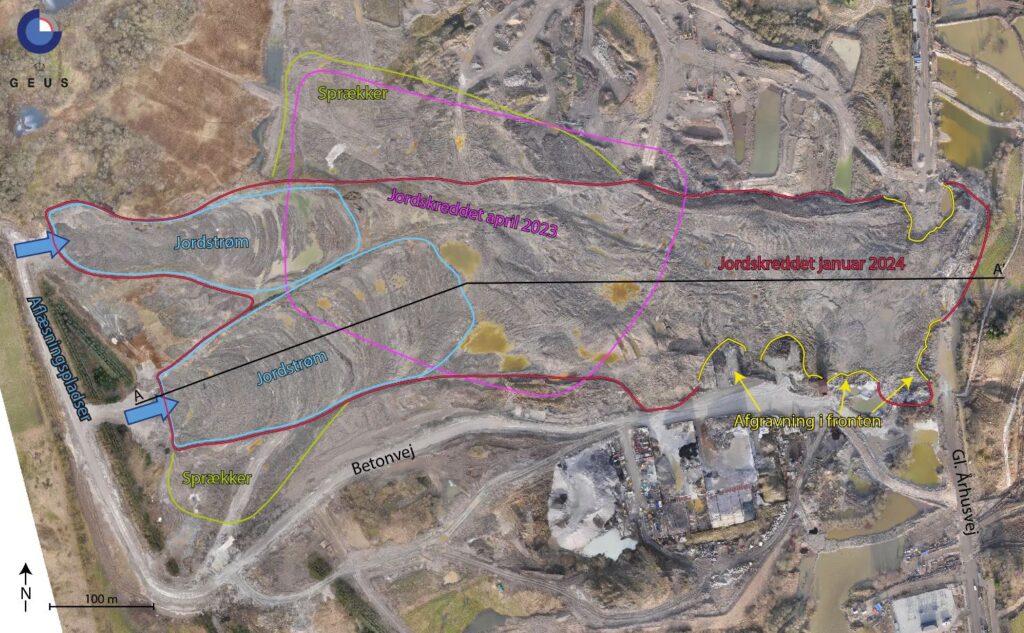The Landslide Blog is written by Dave Petley, who is widely recognized as a world leader in the study and management of landslides.
Exactly a month ago, I wrote about the very large waste landslide that had developed a site then owned by Nordic Waste, a company specialising in dealing with contaminated soil. The site in question is located in the area of the town of Randers, close to Ølst, at [56.3812, 10.0822].
In this case, a large landslide has developed in waste soil dumped in a an old clay pit. There were concerns that the landslide could contaminate the local rivers and even overwhelm Ølst. Nordic Waste declared bankruptcy, leaving the tax payer to cover the costs of remediation, making this a very substantial scandal in Denmark.
The National Geological Surveys for Denmark and Greenland (GEUS) has been undertaking an investigation of the landslide, both to understand the movement of the slope (by examining movement patterns through the second half of 2023) and to develop scenarios for its future behaviour. The report is online as a PDF and there is a summary page that includes the diagrams.
The headline summary from the GEUS report is as follows:-
“GEUS estimates that the landslide at Nordic Waste since mid-2023 has been propelled by earth flows, which were formed by dumping soil from the western slope of the former clay pit, a practice that began in April 2023 and continued throughout the year. It is thus the unloading of large amounts of soil from the edge of the clay pit which has led to the accelerated landslide activity in the latter half of 2023.”
The report includes this image of the site, with the upper portion of the landslide:-

The earthflow form of these upper landslides is clear, and the blue arrow shows how these are driving movement in the soil lower down the slope. The image below shows the entirety of the landslide:-

This image is very powerful. The blue arrows on the left indicate the locations in which soil was being dumped, which has driven the instability. This has created the two large earthflows that are outlined in blue, which has driven the movement of the rest of the mass (outlined in red). Note the toe of the landslide on the far right of the image, which has inundated a road. In yellow, areas of soil that could become involved in the landslide are highlighted.
However, there is some good news in the report. First, the monitoring indicates that the landslide has started slow during January and February 2024, suggesting that it is starting to stabilise. Of course the dumping of soil has now ceased, and material is being removed, so this should be a continuing trend.
And second, the runout modelling indicates that there is no risk that the residential buildings in Ølst will be affect by the landslide, which will be a huge relief to the local residents.
Meanwhile, the Nordic Waste scandal ripples on in Denmark. The local council, Randers Municipality, has now claimed DKK120 million (US$17.4 million) from the administrators of the company, presumably with more to come. There is also a very large (DKK50 million = US$7.2 million) claim from the Environmental Protection Agency. By contrast, the remaining value in the company is estimated to be DKK 724,000 (US$105,000).
This is a stark illustration of the injustice of the case. The evidence that it was dumping of soil at the top of the slope that has driven the landslide indicates that the responsibility for the landslide lies squarely with Nordic Waste. There can be no excuses for failing to recognise the potential for instability, to monitor the slope for potential movement and to cease operations once the failure had started.
Reference
Marie Keiding, Kristian Svennevig and Samuel Paul Jackson 2024. Geological Survey of Denmark and Greenland Report 2024/12 Landslide activity and scenarios for landslide development at Nordic Waste, Randers Municipality. The National Geological Surveys for Denmark and Greenland (GEUS).


